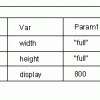|
Mark Richards - FDD & Agile Architecture - NFJS2006 Tour
Podcast
Mark Richards and Bob Payne sit down to discuss agile architecture in this podcast. Mark shares his thoughts on feature-driven development, among other topics in this informative discussion. |
||
|
Going the Distance: Five Tactics to Compensate for Distance on Distributed Teams Teams communicate quickly and freely when they work in the same room. There's no time wasted walking down the hall, going to another floor, or waiting for a return email or call back. Collocation is the most effective arrangement for teams, but that's not always possible. Esther Derby shares five tactics that help teams compensate for distance. |
||
|
Write a Blockbuster Using User Scenarios Big projects require many little user stories. But if these scenarios don't add up to one good story, then you're probably missing out on the big picture. In this week's column, Jeff Patton describes how his team weaves many small tales into a single strong report by identifying key characters and themes. |
||
|
Supercharge Your Application Development Open Source Strategy with an Architecture-centric Approach Application Development Open Source Strategy with an Architecture-centric Approach Today's software developer, like never before, is blessed with a plethora of sophisticated open source tools and technologies to aid his craft in producing market-worthy applications. Leveraging these resources together with the developer's business domain knowledge and agile best practices can quickly yield some truly amazing results To sustain these successes, an application developer must apply an architectural-centric approach in order to realize longevity, flexibility and independence in his application. |
||
|
Dave Thomas - No Fluff Just Stuff 2006 Tour
Podcast
Dave Thomas speaks about the Dreyfus Model of Learning at the No Fluff Just Stuff conference held in Reston, Virginia. |
||
|
Feature-Driven Development: An Agile Alternative to Extreme Programming Feature-driven development (FDD) has the more traditional progression of a systems-engineering life cycle mode as compared to agile methods. It uses distinct phases in its iterations while still being highly iterative and collaborative. FDD does conduct up-front planning, design and documentation and relies very heavily upon domain modeling. |
||
 |
Relating PMBOK Practices to Agile Practices - Part 2 of 4 Michele Sliger understands the turmoil project management practitioners go through in the transition from plan-driven approaches to agile methodologies. Michelle continues her four-part series relating Project Management Institute (PMI) best practices--as identified in the PMBOK--to agile practices. |
|
 |
How to Merge XML Data with a Database In his article "Data Crunching Tips and Techniques," Greg Wilson taught us how to translate legacy data into XML. In the second half, he explains how to merge new data into an existing database. Developers will always face these types of data crunching problems, and knowing the standard data crunching tools can save you a lot of time. Greg also shares the basic knowledge about relational databases that every developer should possess. |
Greg Wilson
April 6, 2006 |
 |
Achieving Agility in Globally Distributed Software Development In today's business climate there exists an ever-increasing demand to achieve more from less. More return from less investment, faster time to market from shrinking resources, higher quality from collapsing timelines. The impact of these pressures on the software development industry has meant that organizations have had to look for new avenues such as offshore development to reduce costs yet still satisfy these increasing demands. Simply incorporating an offshore development strategy to realize lower costs is not a solution. Leveraging the lower cost and resource scalability that an offshore development strategy provides must also include the facilities to enable that capability to produce better results faster. |
|
|
Agile at Scale: 7+7 Practices for Enterprise Agility Part II of II - Seven Additional Practices For Enterprise Agility In part I of this Article, we noted that the benefits of agile software methods, including faster time to market, better responsiveness to changing customer needs and higher quality are undeniable to those who have mastered these practices. However, these practices have been developed and refined in circumstances characterized by small, co-located teams with ready access to a customer. Can enterprises building applications that require hundreds of distributed team members benefit from these practices, or are they forever doomed to large, late, stage-gate and waterfall-like results? |
Pages
Upcoming Events
| Apr 27 |
STAREAST Software Testing Conference in Orlando & Online |
| Jun 08 |
AI Con USA An Intelligence-Driven Future |
| Sep 21 |
STARWEST Software Testing Conference in Anaheim & Online |
| Oct 27 |
STARCANADA Software Testing Conference in Toronto |







